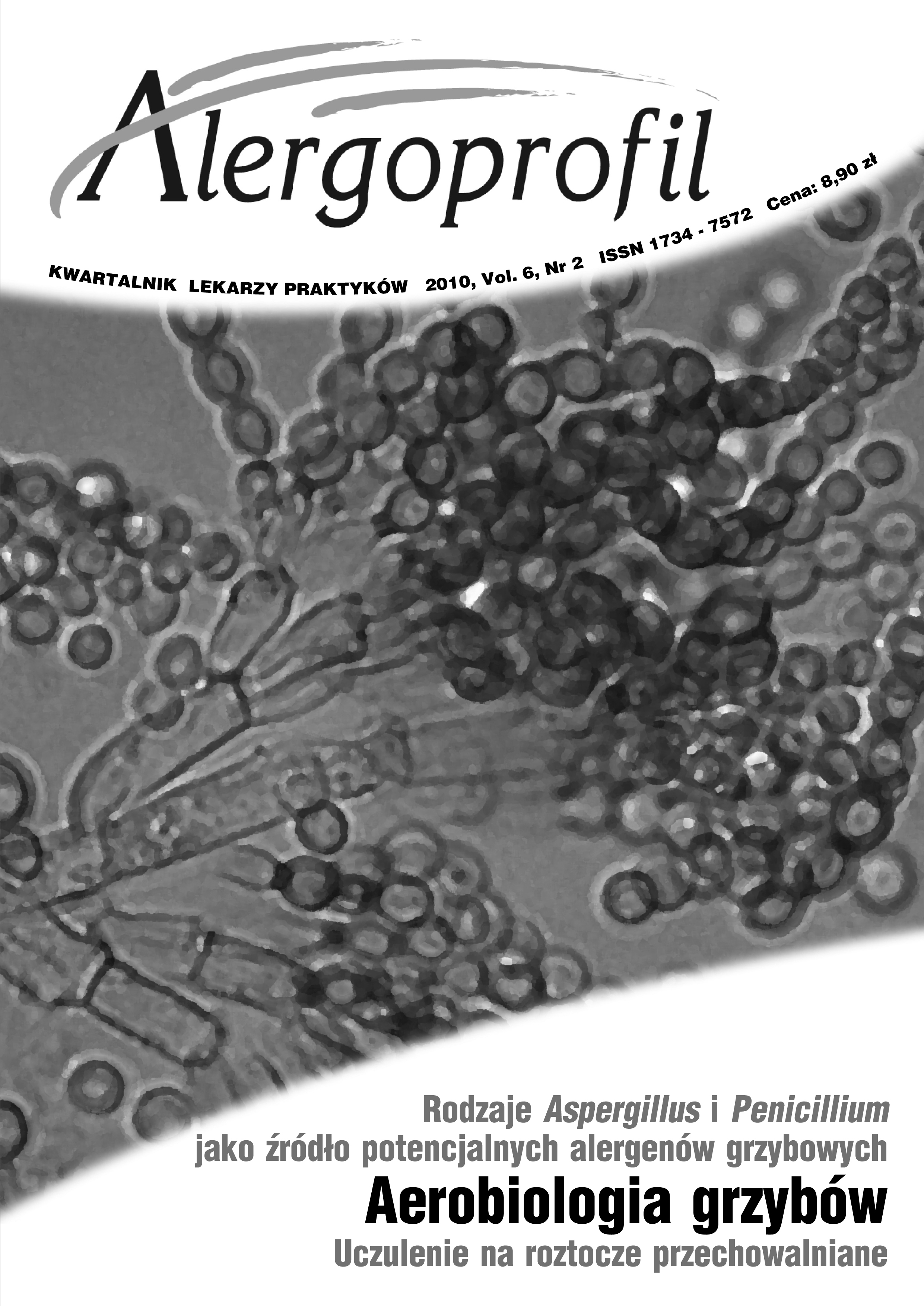Risk of exposure to house dust mites and other arthropods in three Upper Silesian hospitals
Main Article Content
Abstract
The house dust mites (HDM) have been shown to produce allergens causing atopic allergies in human beings, known in medicine as house-dust-mite allergy. A survey of dust samples from three Upper Silesian hospitals located in Katowice was made to determine the occurrence, number and species of mites and other arthropods. A total of 60 samples were examined, always from two sites – floor and patient’s mattresses. Arthropods were present in 41 samples (68.3% of all samples examined). Mites (203 ones) were isolated from 39 samples (65%). The most abundant arthropods were members of the family Pyroglyphidae (HDM), which formed 99.01% of total mite count and 95.71% of all arthropods collected. Among them, Dermatophagoides farinae (DF) was predominant (approx. 65% of all mites collected), followed by D. pteronyssinus (DP) (30.5%). Moreover, single specimens of gamasid and oribatid mites and six ones of book lice (psocids, allergenic insects) were isolated. A mean number of mites per 1 gram of dust from hospitals was 24.3 ±35.0 (range 0.0–180.0), whereas mean values of indoor relative humidity and temperature were 53.9%RH and 22.7°C, respectively. DF was distinctly more abundant per 1 gram of dust than DP, whereas alive mites were more numerous in populations of the second species. Populations of both species were dominated by adult mites. The density of mites was influenced mainly by the type of mattress, number of patients and relative humidity. The research has revealed differences in the occurrence and abundance of both species of HDM between hospitals examined and between particular places within the same hospital. Moreover, the study suggests that HDM and other arthropods, including also some allergenic taxa, should be considered as occupational risk factors contributing to the occurrence of respiratory and dermal diseases among patients and different workers of hospitals. Most probably, HDM are introduced into hospitals by humans from their houses and/or flats.
Downloads
Article Details
Copyright: © Medical Education sp. z o.o. This is an Open Access article distributed under the terms of the Attribution-NonCommercial 4.0 International (CC BY-NC 4.0). License (https://creativecommons.org/licenses/by-nc/4.0/), allowing third parties to copy and redistribute the material in any medium or format and to remix, transform, and build upon the material, provided the original work is properly cited and states its license.
Address reprint requests to: Medical Education, Marcin Kuźma (marcin.kuzma@mededu.pl)
References
2. Solarz K.: Risk of exposure to house dust pyroglyphid mites in Poland. Ann. Agric. Environ. Med. 2001, 8: 11-24.
3. Blythe M.E., Al Ubaydi F., Williams J.D., Smith J.M.: Study of dust mites in three Birmingham hospitals. Brit. Med. J. 1975, 11: 62-64.
4. Rao V.R.M., Dean B.V., Seaton A., Williams D.A.: A comparison of mite populations in mattress dust from hospital and from private houses in Cardiff, Wales. Clin. Allergy 1975, 5: 209-215.
5. Turos M.: Mites in house dust in the Stockholm area. Allergy 1979, 34: 11-18.
6. Babe K.S., Arlian L.G., Confer P.D., Kim R.: House dust mite (Dermatophagoides farinae and Dermatophagoides pteronyssinus) prevalence in the rooms and hallways of a tertiary care hospital. Clinical aspects of allergic disease. J. Allergy Clin. Immunol. 1995, 95: 801-805.
7. Solarz K.: The allergenic acarofauna of house dust from dwellings, hospitals, libraries and institutes in Upper Silesia (Poland). Ann. Agric. Environ. Med. 1998, 5: 73-85.
8. Solarz K.: Pyroglyphidae (Acari: Acaridida) in Poland: Distribution, biology, population ecology and epidemiology. Acta Zool. Cracov. 2001, 44: 435-528.
9. Racewicz M.: House dust mites (Acari: Pyroglyphidae) in the cities of Gdańsk and Gdynia (Northern Poland). Ann. Agric. Environ. Med. 2001, 8: 33-38.
10. Solarz K.: Indoor mites and forensic acarology. Exp. Appl. Acarol. 2009, 49 (1-2): 135-142.
11. Solarz K.: Pyroglyphidae (Acari: Astigmata) of Poland: Distribution, biology, population ecology and epidemiology. Risk of exposure to house dust pyroglyphid mites in Poland. Ann. Acad. Med. Siles. 2003, Suppl. 52: 1-244.
12. Solarz K.: Alergogenna akarofauna pyłu domowego wybranych miast Górnego Śląska. Wiad. Parazytol. 1986, 32: 431-433.
13. Vobrázková E., Kasiakova A., Samšiňák K.: Analysis of dust samples from the clinical environmet of children with eczemas. Ang. Parasitol. 1986, 27: 53-55. Custovic A., Fletcher A., Pickering C.A., Francis H.C.,
14. Green R., Smith A., Chapman M., Woodcock A.: Domestic allergens in public places III: House dust mite, cat, dog and cockroach allergens in British hospitals. Clin. Exp. Allergy 1998, 28 (1): 53-59.
15. Nagakura K., Osaka F., Tazume S.: Detection of fowl mites inside two hospital rooms. Tokai. J. Exp. Clin. Med. 1998; 23 (4): 173-176.
16. Solarz K.: Some species of mites (Acari) from house dust in Upper Silesia (Poland). Acta Zool. Cracov. 2000; 43: 241-259.
17. van Bronswijk J.E.M.H.: House dust biology (for allergists, acarologists and mycologists). NIB Publishers, Zoelmond 1981.
18. Pope A.M., Patterson R., Burge H.: Indoor allergens. Assessing and controlling adverse health effects. National Academy Press, Washington 1993.
19. Baz A., Monserrat V.J.: Distribution of domestic Psocoptera in Madrid apartments. Med. Vet. Entomol. 1999, 13: 259-264.
20. Patil M.P., Niphadkar P.V., Bapat M.M.: Psocoptera spp. (book louse): a new major household allergen in Mumbai. Ann. Allergy Asthma Immunol. 2001, 87 (2): 151-155.
21. Arlian L.G.: Arthropod allergens and human health. Ann. Rev. Entomol. 2002, 47: 395-433.
22. Auerswald L., Lopata A.: Insects – diversity and allergy. Curr. Allergy Clin. Immunol. 2005, 18 (2): 58-60.
23. Green P.W.C.: Substrate selection by Liposcelis bostrychophila Badonnel (Psocoptera: Liposcelididae): effects of insect extracts and biodeteriorated book-paper. J. Stored Prod. Res. 2005, 41: 445-454.
24. Stejskal V., Hubert J.: Risk of occupational allergy to stored grain arthropods and false pest-risk perception in Czech grain stores. Ann. Agric. Environ. Med. 2008, 15: 29-35

